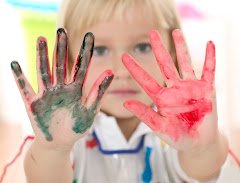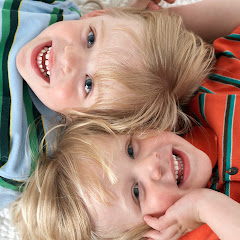Wednesday, January 28, 2009
Social Emotional Needs of Special Needs Children
I used to think that preschoolers were pretty accepting and they often are, but not always. As time goes on they can loose interest in the child whose speech is not understandable, or decide not to play with the child whose hyperactivity disrupts their play. I've seen children, who otherwise have exceptional social skills refuse to hold the hand of a child who has a slight deformity. Is it because of the deformity, because the child's lack of speech skills or the behavior of the child in class? Probably a little of each. And the action of other children affects the way the child with the special need feels about him or herself.
Social emotional assistance should always be considered when we are determining the needs of a young child with a a special need. It is important to find ways for the child with articulation difficulties to communicate with others. So often teachers are told to teach children to use their words when there is a conflict, but when a child is physically unable to do this, the advise often sounds something like this, "It will get better when the child's speech catches up." That cannot be an acceptable answer. We've got to find a way to make an effort to teach the group sign language, use picture cards or whatever is necessary to help that child be a part of the group. Leann taught us at the Governor's Institute to use social stories and I think that is a valuable start. There are a number of websites which can give you more information on using social stories with children but I think the following is one of the best: http://www.vanderbilt.edu/csefel/practicalstrategies.html
Marisa Macy, assistant professor of special education, at Penn State suggests teachers use the strategy of embedding social-emotional instruction throughout the day. If you would like to learn more about her work, you can go to: http://www.ed.psu.edu/educ/news/news-items-folder/embedding
Here are a few books which may help your class be more accepting of differences in others:
Zoom! by Robert Munsch
Susan Laughs Jeanne Willis
Leo the Late Bloomer Robert Kraus
Friends at School by Rochelle Bunnett
We Can Do It, by Laura Dwight
My Friend Isabelle (Hardcover) by Eliza Woloson
As I said when I started, I have a lot more questions than answers. Please share your thoughts and help me and others help all the children in our lives increase their social emotional skills.
Saturday, January 17, 2009
Gun Play-Looking for Answers
Right now the gun play in my class is not all "bad guy" play. It is related to family members being in the military and families in which adults hunt for food. When a child has a parent serving in the Army, he often wants to role model that parent. I allow other children to role model their parents, but am I to say to this child that he cannot? As a country, we recognize and praise those who are serving in the military, but children in the classroom are told it is not ok to play soldier. This sends a very conflicting message. I allow other negative topics such as house fires and doctors who have patients that die, but not gun play. Am I giving more power to the gun play because of my stance?
I feel that teaching the children that soldiers do much more than shoot guns is part of the solution, but that is not enough. I'm "thinking out loud" as I write this, but maybe it would be positive to have a class meeting on the topic of guns and soldiers. I sometimes avoid these topics, wishing not to worry children who have not been exposed to such topics. How silly of me, when several of the boys are spending as much time as possible figuring out how to get away with gun play. "It is just a bubble machine gun." "It's not a gun, just a water shooter." It could be that recognizing the child and his dad's job might be the best way to handle the situation. We could talk about our respect for those serving in the military, but at the same time point out that none of the children in the room are enemies. Some children might express their feelings and as a group we might be able to work through these things. The child who wants to emulate his dad would feel proud and and yet at the same time he could hear why others ( the teachers) did not want gun play in the room. We could talk about the end of goal of soldiers is to bring peace. It might not solve the problem, but it could give me insight into what he and the other children are feeling. It could be a starting place.
Please share your thoughts on this topic. I need all the wisdom you have to offer!
Saturday, January 10, 2009
Appreciating Differences-Non-Fiction Books
I also like the Around the World series of books, most by Ann Morris and Ken Heyman. They include Bread, Bread, Bread, Houses and Homes, Shoes, Shoes, Shoes, Play, Families, Tools, On the Go, and Loving. These simple books show clear photos and are appropriate for the youngest preschoolers. After reading one of these, the children can share info about themselves. With the book Bread, Bread, Bread, it would be good to have various breads available for the children to try. Part of social emotional growth is being open to trying new things.
Appreciating Differences
The Jellybeans and the Big Dance by Laura Numeroff and Nate Evans, illustrated by Lynn Munsinger (2007) is a great story to help children appreciate the differences in others and build a sense of community. The main character, Emily, is disappointed to find that the other girls in her new dance class are very different from what she expected. In the end though, it is the differences which makes for a happy ending. After reading and discussing this book, plan a project in which the children can share their talents. You might plan a special day, a show or make a class garden. No matter what you do, make sure the children each contribute their special abilities. If you want a simpler project ask children to bring ingredients for a recipe such as bread or cookies. Discuss how all the ingredients work together to make a delicious treat. Another simple activity would be to talk about how each child contributes to the classroom or how family members contribute to the family. Thank you to Bernice for recommending the book. If you have a good story to build social emotional skills, please share it with us.
Elmer by David McKee. Elmer is a brightly colored elephant who wishes to plain gray, just like the others elephants. The story shows Elmer’s effort to fit in, but in the end, he realizes the elephants like him just the way he is. After reading this story, I usually give the children a large elephant ( sometimes finger paint paper, other times construction paper) to decorate or paint. Each child is encouraged to use his own ideas to create an elephant, but children could also work together on one elephant. We then admire all the elephants and appreciate them and their creators. This is a great way to teach about differences and also build a sense of community.

